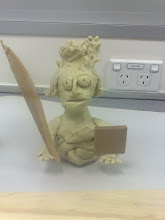For our first charrete session we were divided into groups and were tasked with finding solutions for an IKEA chair that were given to us. Here is a breakdown of solutions to those tasks.
The Ivar Chair given to our group.
Our first task was a mind mapping session to various problems of the particular chair.


The following are several design solutions to problems related to the user.
1. Prolonged use of product
Several options of modification to the chair. These included interchangeable backing, steel-made replacements for the legs as well as interchangeable shapes for the seats.

Stack-able/modular solution to the chair which provides easier storage if users purchased several of the Ivar chairs.

This solution focused on being able to fit a bag attachment. This can be used for extra storage space or be turned into a bin for rubbish.
2. Physiological Pleasure after market parts
Various design considerations for physiological pleasure of users. Tarp finish and contoured finish seating modifications. Solid curved backing for comfort.

Tarp attachment to replace wooden seat. Hooks on its side are to clip to the seating frame of the chair.
3. Psychological/sociological after market attachments/products.
Cushion padded sleeve to be placed over the back support of the chair.

Height adjusting extension. To provide option to adjust height of seat. Top face fits underneath the chair.

Leg extender for chairs. With height provided, chair can now be used as a bar stool.
A final modified design of the chair was then decided upon, and the following is the subsequent final design as well as a hero shot.


Storyboards we're also produced to illustrate the chair during the purchase process as well as its new modifications and new uses.

 Thoughts on Final Design
Thoughts on Final Design
For our final design, we decided for further physiological pleasure, we were to include our idea of a more comfortable backing as well as an improved curved finish to the original seat. Added to this was also the extra foot rest placed at the front bit of the chair frame. Wedges were also added to the front legs to have the chair rest at a more comfortable angle for the user. A further modification made to the chair was also the option to now be able to have extra storage space underneath the seat, similar to the storage space found in piano chairs.
Reflection
For this first charette exercise that we did, I found that our design capabilities were really tested with the format of quick and short periods given to come up with various solutions for the various design problems we had found. Coming up with a final solution at the end also allowed us to work together as a team, agreeing as well as disagreeing on design decisions. This would probably replicate a similar scenario in our future as designers, learning to be able to work with others to come up with a design solution. Overall, this charette was definitely helpful in exchanging ideas as well as working on our own in improving our pace and quality of our design.























